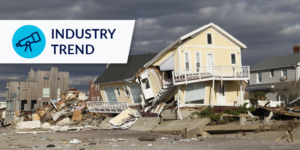
10 years after “Superstorm” Hurricane Sandy hit New York and New Jersey’s coastal areas, reports of contractors still remaining unpaid — as well as residents being unable to receive disaster aid needed to pay them — are still coming into New York’s Department of Design and Construction.
One such contractor is Navesink Prestige, which has worked on 284 homes throughout Queens, Brooklyn, and Staten Island. Their work was financed by the Build It Back Act, which received over $2.7 billion in federal grants to not only help rebuild homes but help rebuild the coastline and clear debris.
A primary challenge for many of these contractors is that many onsite conditions differed from the conditions described in the documents they signed to obtain this work. Contractors like Navesink began experiencing difficulty getting change orders approved as the department’s federal grants started to run dry.
Many storm survivors also unfortunately have experienced contractor fraud or simply had trouble finding the proper government office to help.
One survivor described how he waited two years for government aid only to find he needed flood insurance to qualify, which he couldn’t afford as the premiums had skyrocketed.
Related coverage: Hurricane Ian’s Aftermath Creates Breeding Ground for Fraudulent Contractors
The increasing severity of these natural disasters and the increasing bureaucracy across the U.S. is only set to make contractors like Navesink Prestige more anxious to receive payments.
“Our biggest beef now is this process the city is putting us through,” said Brian Lawrie of Navesink Prestige, contending that the city’s public works builder is withholding payment based on a technicality.
“They drag every contractor through this process. They’re costing me hundreds of thousands in legal fees. Every single contractor who works with the city is tortured.”
Another company, Arverne by the Sea, also claims they are owed “a large sum” for their Build Back Better work by the New York housing agency.
“We’re still owed money,” claimed Gerry Romski, who oversaw Arverne’s work for Build it Back. “But I fully expect that we will be compensated for the work we did.”
Romski told The City in October that he hoped the company would have been repaid before the 10-year anniversary of Sandy, which passed on October 29 — but had no such luck. He however remains optimistic that New York City Mayor Eric Adams’ administration will make sure Arverne is finally compensated.
Further compounding the efforts to help victims of Hurricane Sandy are contractors like Hammerman and Gainer (HGI) that were rewarded with large portions of the funds for this project, only for alleged shoddy work and misappropriation of funds to occur.
HGI was awarded one of Build It Back’s biggest contracts, for $780 million, and their contract was later terminated after reports of alleged shoddy work by their subcontractors — and later, donations made by the firm to an organization to reelect Chris Christie, then-governor of New Jersey.
An op-ed in The Hill advocated against rewarding such contractors like HGI for what they called “sweetheart contracts.” The amount of federal aid is normally grossly under-estimated while the more socially vulnerable communities are ignored, and the government is still vastly underprepared for such predictable storms.
Additionally, many projects that started soon after Hurricane Sandy have stalled or run out of money. These projects include repairing subway lines in Queens, building flood protections for Coney Island Yards, and restoring wetlands to better receive the storm waters. 12 years later, money is still being distributed by the federal government to fund these projects, including $467 million awarded to the MTA as part of a $7.8 billion initiative.
Despite the widely known reconstruction problems with Hurricane Sandy, similar reports are coming of survivors and contractors struggling to rebuild or get paid in the aftermath of Hurricane Ida in Louisiana and Hurricane Ian in Florida.
Two contractors based in Louisiana’s LaFourche Parish were arrested after several reports of incomplete or shoddy work to repair damages from Hurricane Ida. The Better Business Bureau has received many reports of unlicensed contractors charging Florida residents for work that has not yet been completed.
Such stories have increased the call for less red tape and reforms of the disaster aid process for contractors and these storm victims. Some reforms include having a single point for application to disaster aid, a cap on annual flood insurance premiums, and giving mitigation costs of storm repairs to the contractors upfront instead of after the work is done.
The Hill’s op-ed called for FEMA to start including the expenses of surviving such storms, and to remove roadblocks to programs that provide any disaster aid to more vulnerable communities. For instance, the Department of Housing and Urban Development must reapply every year to Congress to access some funds for long-term disaster recovery.
Although FEMA has already approved a disaster aid program for Florida residents affected by Hurricane Ida, Senator Marco Rubio argued against such aid for New Jersey and New York after Hurricane Sandy. Despite his previous stance on aid after Sandy, Rubio’s program for Hurricane Ida includes $12 billion for the Army Corp of Engineers to install flood controls and $10 billion to replenish FEMA’s disaster fund.